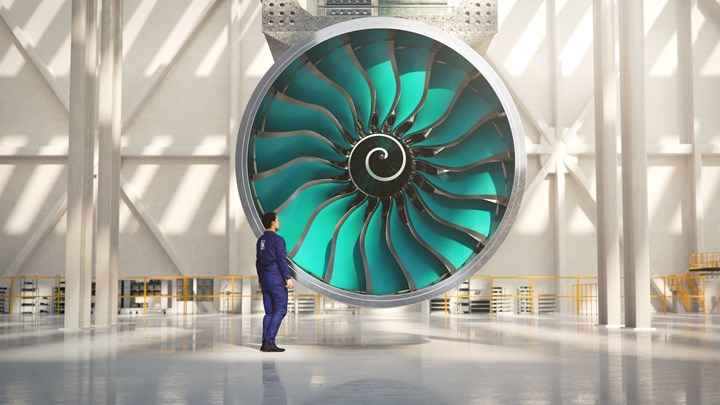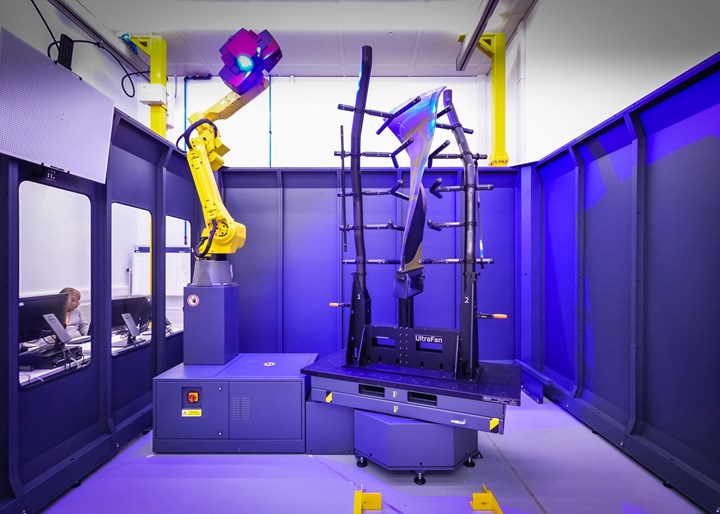Rolls-Royce starts manufacture of world's largest fan blades, made with composites, for UltraFan demonstrator
CFRP blades and fan case cut weight for twin-engine aircraft by 700 kilograms

Composite fan blade in production at the Rolls-Royce composite technology center in Bristol, U.K. SOURCE for all images | Rolls-Royce
Rolls-Royce (London, U.K.) has started manufacture of the world’s largest fan blades, for its UltraFan demonstrator engine that will set new standards in efficiency and sustainability. This milestone marks the official start of parts production for the demonstrator.

Artist rendering of the UltraFan featuring a 140-inch-diameter set of 18 composite fan blades.
CFRP blades
The UltraFan engine will reportedly set new standards in efficiency and sustainability, offering a 25% reduction in fuel burn and emissions compared to the first generation of Trent engines. Part of that efficiency improvement comes from UltraFan’s composite fan blades and fan case, which cut weight on a twin-engine aircraft by 700 kilograms, the equivalent of seven people with luggage.
As a set, the composite blades have a 140-inch diameter, which is almost the size of a current narrowbody aircraft fuselage. They are being made at the company’s technology hub in Bristol, U.K.
The fan blades are made from 500 plies of Hexcel’s (Stamford, Conn. U.S.) HexPly M91 carbon fiber-reinforced, high-toughness and impact-resistant epoxy prepreg. Hexcel supplies the slit tape for automated layup. The blades are autoclave cured using heat and pressure, precision machined and then coated before a thin titanium sheath is bonded to the leading edge, which protects against erosion, foreign objects and bird strikes. The composite titanium (CTi) blades are inspected and measured using metrology and ultrasound testing.

Composite fan blade being scanned at Rolls Royce composites technology center using a GOM Metrology system.
Bristol composites facility
The Bristol composites facility dates back to Composite Technology and Applications Ltd (CTAL), a joint venture between Rolls-Royce and GKN Aerospace (Redditch, U.K.) established in 2008. CTAL brought together Rolls-Royce’s expertise in advanced engine technologies with GKN Aerospace’s capabilities in composite research and automated manufacturing. U.K. Government funding to support Rolls-Royce’s composite technology research and development also began in 2008 and was used to establish a CTAL facility on the Isle of Wight in 2012. Rolls-Royce announced in 2015 that it would move the CTAL capability, including equipment and 30-40 personnel, to Bristol in 2017.
Rolls-Royce reported in 2015 that the pre-production composite facility would be developed within an existing building alongside its new facility for carbon-fiber composite electrical harness rafts, which was then in the process of being built on the Bristol site. Both facilities benefit from manufacturing techniques developed in partnership with the National Composites Centre (NCC) in Bristol, as well as research conducted at the Rolls-Royce University Technology Centre at the University of Bristol.
Key element in sustainability strategy

Rolls-Royce carbon fiber composite titanium (CTi) fan blade for the Advanced Low Pressure System (ALPS) demonstrator.
Composite blades have already been extensively tested on an Advanced Low Pressure System (ALPS) development engine, including in-flight testing on the Rolls-Royce Flying Test Bed. ALPS is a partnership between Rolls-Royce, Clean Sky, Innovate UK, BEIS, ATI, ITP Aero and GKN. The portfolio of technologies being developed to enable UltraFan is supported by ATI, Innovate UK, LuFo and Clean Sky 2.
UltraFan is a key element of Rolls-Royce’s sustainability strategy, which involves continual research to improve gas turbine performance as well as pioneering electrification and working with industrial partners to accelerate the incorporation of sustainable aviation fuels. It is also part of the Rolls-Royce IntelligentEngine vision, which brings together its products, services and digital technology.
UltraFan, which will start ground tests in 2021 and be available towards the end of this decade, is a scalable design from 25,000 to 100,000 pounds of thrust. It also features:
- A new engine core architecture – to deliver maximum fuel burn efficiency and low emissions
- Advanced ceramic matrix composites – heat resistant components that operate more effectively in high turbine temperatures
- A geared design to maximize high-thrust, high-bypass ratio engine efficiency.
“This is the decade of UltraFan and it’s exciting to enter the 2020s with the start of production of the demonstrator engine,” said Chris Cholerton, Rolls-Royce president for civil aerospace. “We have got all the building blocks in place, the design, the technologies, a brand-new testbed, and now we are actually seeing the engine come together.”
Related Content
PEEK vs. PEKK vs. PAEK and continuous compression molding
Suppliers of thermoplastics and carbon fiber chime in regarding PEEK vs. PEKK, and now PAEK, as well as in-situ consolidation — the supply chain for thermoplastic tape composites continues to evolve.
Read MorePlant tour: Airbus, Illescas, Spain
Airbus’ Illescas facility, featuring highly automated composites processes for the A350 lower wing cover and one-piece Section 19 fuselage barrels, works toward production ramp-ups and next-generation aircraft.
Read MoreIndustrial composite autoclaves feature advanced control, turnkey options
CAMX 2024: Designed and built with safety and durability in mind, Akarmark delivers complete curing autoclave systems for a variety of applications.
Read MoreComposites manufacturing for general aviation aircraft
General aviation, certified and experimental, has increasingly embraced composites over the decades, a path further driven by leveraged innovation in materials and processes and the evolving AAM market.
Read MoreRead Next
“Structured air” TPS safeguards composite structures
Powered by an 85% air/15% pure polyimide aerogel, Blueshift’s novel material system protects structures during transient thermal events from -200°C to beyond 2400°C for rockets, battery boxes and more.
Read MoreDeveloping bonded composite repair for ships, offshore units
Bureau Veritas and industry partners issue guidelines and pave the way for certification via StrengthBond Offshore project.
Read MoreAll-recycled, needle-punched nonwoven CFRP slashes carbon footprint of Formula 2 seat
Dallara and Tenowo collaborate to produce a race-ready Formula 2 seat using recycled carbon fiber, reducing CO2 emissions by 97.5% compared to virgin materials.
Read More

























